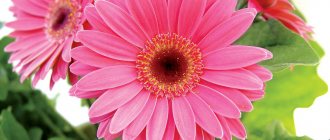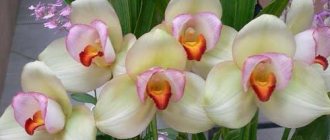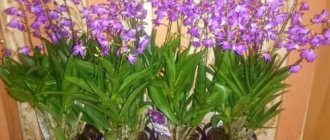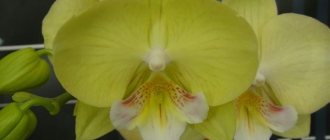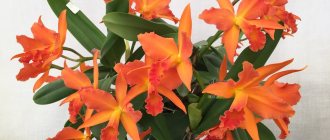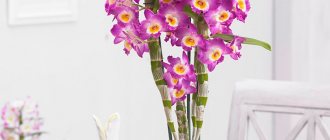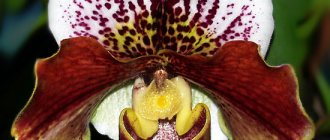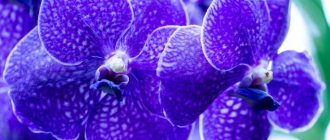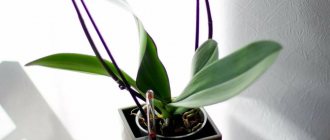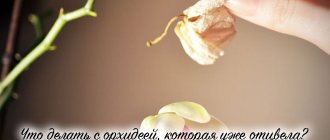Only a few of the 35 or 45 species of the genus Lycasta are suitable for growing indoors, since most are large orchids for which window sills are too cramped a space.
The plant's homeland is a narrow strip of territory running from the southern provinces of Mexico along the mountain slopes of the Andes through Ecuador and Colombia and further to Bolivia and Peru. Some species live far from their main range - in Jamaica, Cuba, the Caribbean islands and the Brazilian state of Mato Grosso. In Guatemala, one of the natural species - the Skinner's lycaste, or maiden orchid - is especially revered and has been elevated to the national symbol of the country under the name White Nun.
The beautiful flower presumably received its generic name from the name of the daughter of King Priam, the ruler of the legendary Troy, mentioned by Homer in one of his works.
Almost everywhere, orchids grow at an altitude of 1 thousand to 2 thousand m above sea level; they are not found lower or higher. The climate of the extreme points of distribution is a humid, warm or temperate season, followed by a cold and dry season, or constantly damp, cool weather with almost imperceptible temperature fluctuations after changing seasons.
Appearance of the plant
Lycastes have a sympodial growth form. Two or three ovoid or pear-shaped pseudobulbs are connected by a rhizome. From their top grow 2–3 folded leaves, elliptical or elongated-oblong in shape. Peduncles, shorter in some species, up to half a meter in others, appear from the base of the pseudobulb, in numbers of 2–5 or more than ten in yellow-flowering varieties, but each bears a single flower with a circumference of 5 to 20 cm, incredibly beautiful and fragrant.
The petals themselves are small, covering the column, but the sepals are much larger, located at an angle of 120 degrees to each other and form a kind of triangle. It seems like a wax flower, its petals and lip are so tight. The palette of shades is different - from white and soft pink to greenish-yellow, orange and brownish. Flowering usually begins in summer and lasts about two months, but winter-flowering species are also found in the genus.
Dendrobium
At the moment, there is simply an incredible number of orchids of the genus Dendrobium. The flowers of the plant can be painted in a variety of colors, and they also differ in size. The leaves are very small in size. Particularly popular are species that feel comfortable even at low temperatures. Experts advise not to expose the plant to direct sunlight. In winter, the room where the orchid is located must be kept dry and at a constant temperature.
Dendrobium
Substrate for growing and planting lycastes
In nature, lycaste grows on the ground or on trees covered with moss; at home, it is grown in pots filled with a breathable substrate consisting of chopped fern roots or the bark of deciduous trees, sphagnum moss, dry leaves and medium fractions of charcoal in a ratio of 2: 1:1:1.
Lycaste is usually replanted annually; both the flower container has to be changed, because the pseudobulbs formed during the period between transplants are cramped in the old pot, and the substrate, since plants react extremely negatively to its salinity.
During transplantation, carefully inspect the roots. Those that are dead or show signs of damage are removed, and the cut-off areas are crushed with crushed charcoal powder to prevent fungal or bacterial infections from penetrating the wound.
Oncidium
Most orchids of this species have bright flowers that visually resemble butterflies. However, such plants are difficult to grow indoors, as they require good ventilation and constant levels of temperature and moisture. As soon as the orchid has finished blooming, the pot should be placed in a dark place and watering should be kept to a minimum. Oncidium hybrids are not so demanding to care for, but their flowers are small in size and cannot boast of bright colors. The leaves of oncidium are long and thin.
Oncidium
In this article we talked about what varieties of orchids exist. We also focused on a detailed description of the species, namely the shape of the leaf blade, by which rare plant species can be distinguished. Don't forget that each type of orchid requires special care. Only in this case will the plant delight you with beautiful flowers.
Lycasta care
It is impossible to develop uniform rules of care for all lycastes, since they grow in different climatic conditions in nature, although the numerous hybrids and varieties that have been bred are more acclimatized to home conditions than natural species.
Placement in the house and requirements for temperature and lighting
Lycasta will take root well on the windowsill of a large window facing west or east; on a south window it is too hot in summer, and the plant will need shading from scorching rays. In northern rooms, the orchid develops inactively and often refuses to bloom. In winter, most lycastes enter a resting phase, and they do not need additional lighting, which cannot be said about varietal and hybrid orchids.
The temperature during the period of active development ranges from 22 to 27 degrees Celsius. When the plant begins to prepare for rest and shed its leaves, the temperature in the room is gradually reduced to 15 degrees above zero, and during dormancy the lycaste is placed in a cool, about 12 degrees Celsius, and dry room. For active flowering, most species require a nighttime temperature decrease relative to the daytime thermometer readings by 6–10 degrees. In spring, lycastes are taken out into the garden and placed in places protected from drafts under the diffused light of tree crowns.
Watering, spraying and fertilizing lycastes
The watering regime for lycasta is developed individually depending on the climatic conditions in which the plant grows in nature. Orchids of temperate latitudes develop well in conditions of low air humidity - 35–45% and require not too frequent and abundant watering. It is necessary to focus on the condition of the substrate; naturally, you cannot allow too much drying, but overwatering will have an immediate effect - the first symptoms of rotting of the root system and the base of the pseudobulb will appear.
Important! When watering and spraying, do not allow water to get into the center of the new growth.
The plant responds well to watering by immersion in a container with warm and soft water for 10–15 minutes. After removing the pot with the orchid, you should allow the water to drain well through the drainage holes and only then return the lycaste to its permanent place of keeping.
Flower growers have different opinions regarding spraying. Some argue that lycastes need regular sprays of moisture during the warm season, others argue that in orchids of this genus, after drops of water fall on the leaves, small black spots appear and they advise spraying only the flower, and blot the moisture that gets on the leaves with a dry napkin. In this regard, it is worth noting that the need for spraying depends on many factors - living in nature, indoor microclimate - temperature, lighting, as well as air ventilation and others.
During the active growing season, lycastes are fed with special fertilizers for orchids, diluted in half or a quarter dose relative to that indicated on the package. The frequency of fertilizing is through watering.
Cymbidium
This species is distinguished by its large size, but currently dwarf orchids are grown indoors. Such plants are most suitable for beginners who are just starting to get involved in floriculture. Each stem can bear 20 or more flowers, which last for 2-3 months. This orchid will delight you with bright buds in the autumn and winter seasons. After the last flowers fall, watering should be reduced to a minimum and the plant should be left alone. In the summer, we recommend taking the cymbidium out into the open air, placing it in a shady place. In winter, the orchid will feel comfortable in a cool room. The plant needs sunbathing in the morning and evening hours. You can identify a cymbidium orchid by its ellipse-shaped leaves.
Cymbidium
Leaf fall and dormant period
Caring for lycaste in winter differs from maintenance during active growth. In many sources there is a statement that a characteristic feature of plants of the genus is the loss of leaves every dry season, i.e. during dormancy. However, this does not apply to all species; in some, the leaves do not fall for 2–3 years and only then die.
With the beginning of the resting phase, they stop feeding the lycaste and practically do not water it, but they monitor the condition of the pseudobulbs, trying to prevent them from shrinking. If such symptoms appear, the pseudobulbs are moistened with a spray bottle, but not abundantly - during this period, under conditions of cool dormancy, the plant is very vulnerable to various types of infections.
Hybrid lycasts do not always go into a dormant phase, but continue to develop, forming new growths and peduncles. In winter, they require additional lighting, a room temperature of no higher than 24 degrees Celsius and moderate watering.
What groups of these colors are there?
All orchids can be divided into two large groups:
- sympodial;
- monopodial.
A characteristic feature of the first group is the death of the apical bud or its movement into the inflorescence. As soon as the shoot reaches a certain size, it stops growing and produces a new shoot. Sympodial orchids also produce thick stems, which later turn into tubers (bulbs).
Attention : Monopodial orchids, on the contrary, are characterized by an apical bud. This means that the plant can grow in length throughout its life, especially the vine or rosette species.
Thanks to such a pronounced division, it will not be difficult to distinguish one group from another, and, accordingly, understand how to grow and care for this marvelous flower. But it is still worth considering that each variety, species or hybrid requires an individual approach .
Reproduction of lycastes
Seed and meristem methods of propagation are not used at home, only in greenhouses and greenhouses. For lycastes grown on a windowsill, dividing the rhizome during transplantation is most appropriate.
An adult bush with several pseudobulbs, after immersion in water, is carefully removed from the flower container and the root system is freed from the old substrate, carefully handling the fragile roots. The rhizome is dissected with a disinfected sharp knife so that 2–3 pseudobulbs and young growth remain on each section. The incision sites are crushed with crushed charcoal to protect against fungal infections. The delenki are planted in a new substrate and cared for in the same way as adult lycastes.
Most common colors
Flowers can come in a variety of shapes and shades. The most common plants found are :
- With whites;
- Red;
- Purple;
- Brown;
- And yellow flowers.
They can also be painted with a mixture of several colors and have a design or pattern.
Diseases and pests
Some problems with the condition of the flower are directly related to errors in care. From a lack or excess of lighting, yellowing of the leaves is often observed, and the appearance of black spots on them is associated with spraying and drops of water falling on the leaf plate. Sometimes a slowdown in growth becomes apparent, accompanied by a lack of flowering. There are several reasons for this phenomenon - salinization of the substrate due to untimely replanting and watering with hard water, lack of nutrients, non-compliance with the rest period.
Among the diseases, the most common are various rots caused by fungal or bacterial infections in conditions of excessive moisture.
The most common pests on lycastes are mealybugs and scale insects, and in conditions of low humidity, spider mites also appear. If few insects are found, they are washed off with a 20% soap solution. In case of numerous lesions, plants are treated with insecticides.
Brassia
The Brassia orchid is often also called the Spider orchid. It differs from other varieties in its unusual appearance. The petals resemble thin threads. The flowers are light green and the inflorescence has a very elegant shape. But the leaf blade is somewhat reminiscent of a lancet; it tapers towards the edge. Some people find the aroma of brassia extremely pleasant, while others find it extremely unpleasant. The orchid begins to bloom in late April-early May. When the flowering period ends, Brassia needs rest for some time. Therefore, at this time the plant does not require abundant watering until the growth period begins. This type of orchid is the simplest and most unpretentious to care for; it can be kept at room temperature, and in winter the orchid can withstand fluctuations of up to 10 degrees. She feels best away from direct sunlight.
Brassia
Types of lycastes
Virgin, or Skinner's (virginalis) is one of the most beautiful plants in the genus. A pair of ovoid leaves is formed from the pseudobulbs. The peduncles grow up to 25–35 cm, and white-pink fragrant flowers about 15 cm in circumference form on their crown. The lip is three-lobed with a slight yellowness or pure white or with barely noticeable crimson to purple streaks and small polka dots. It blooms throughout the month from late autumn to early winter, but the peak of active bud formation occurs from January to mid-spring. Thanks to its long peduncles, the orchid is used for cutting. Hybrids of Japanese selection are especially popular among flower growers, for example, lycasta sakura with short leaves and a large pink flower with a diameter of up to 9 cm, in the creation of which the breeding material of this species was used for 80% and 6–7% each from the types of lycasta large-leaved, blood-red and krinites.
Virgin, or Skinner's (virginalis)
Short-winged (brevispatha) is a compact plant with peduncles shorter than the leaves. The sepals are greenish in color, sometimes with pink dots and tips bent back. The petals are snow-white with a slight pale pink tint. The lip has a weakly defined three-lobed outline, white, occasionally with barely visible light pink specks.
Short-winged (brevispatha)
Aromatica (aromatica) is one of the most popular lycastes in indoor floriculture with yellow-orange flowers that exude a subtle spicy aroma. Two varieties are known: one with small flowers with a circumference of no more than 4–6 cm, narrow sepals and anterior lip blade, the second with larger flowers with a diameter of up to 8 cm, with wide perianth lobes.
Aromatica
Cochleata - with small yellow flowers about 4 cm in circumference and a characteristic expressive swelling at the base of the lip, steeply curved downwards. Blooming flowers smell like chocolate.
Cochleata
Blood red (cruenta) is a small orchid with short flower stalks, cinnamon-scented flowers at the top located below bright green oval leaves. It is not clear on what basis the name was given to the species, because the flowers of the plant are orange-yellow, and the red spot at the very base of the lip is visible only if you look closely. The sepals are yellow-emerald in color and are effectively bent back. Flowering in this species lasts for one and a half months, and leaf fall occurs once every 2–3 years.
Blood red (cruenta)
Macrophylla is a large plant up to 70 cm high with thick ovoid pseudobulbs almost 10 cm high and 3–6 cm in diameter in cross section, often flattened on the sides and several longitudinal grooves. From the tops of the pseudobulbs, 2–3 fan-shaped leaves are formed, 45 to 75 cm long, which fall off at the beginning of winter. The peduncles are short, no more than 18–20 cm, with one flower at the top, large and fragrant. The color of the sepals varies from olive greenish and light brown to dark chocolate. The petals and lip are white, often with small pinkish, scarlet or purple small polka dots. Peak flowering is in May, but often forms flower stalks at other times of the year.
Macrophylla
Species features of indoor orchids
Orchid is a beautifully flowering ornamental plant that belongs to the orchid family. There are more than 25 thousand varieties and hybrids around the world. This is one of the most beautiful indoor plants, which is often given as a gift or used to make bouquets.
Plants are divided into two main groups
- Monopodial. They grow vertically in height and have one long stem. Several flower stalks emerge from shoots (pseudobulbs), which contain all the necessary nutrients and trace elements for healthy growth. Wide flat leaves have a rounded shape.
- Sympodial. They grow wide and look like vines with many shoots. They are united by a rhizome (rhizome), which serves as a stem. Pseudobulbs subsequently appear on it, from which new buds grow. Due to this, they visually look more bushy than monopodial ones, while the leaves of such specimens are narrow and oblong.
Each type has a different aroma with dominant notes of lemon, cinnamon and even coffee beans. Some have a barely perceptible sound, while others, on the contrary, scent the entire room.
On average, orchids bloom about 2-3 times a year, but there are varieties that, with proper care, delight with lush blooms all year round. Some varieties may have inconspicuous buds and inflorescences, but this is compensated by the beautiful and bizarre shape of the leaves. The shapes of inflorescences and color options depend on the variety. The peculiarity of the flower is symmetry. It consists of three sepals, two lateral petals and a central part - the lip. It can be painted in the color of the rest of the petals, stand out in a different tone or with bright splashes.
Not only leaves and stems take part in photosynthesis, but also the root system. Therefore, for most varieties, only transparent containers are suitable instead of ordinary pots. It is also better to leave some root branches above the ground.
- House plants
Garden at home: 9 best flowering indoor plants with names and photos
Reviews
Oksana, Moscow: “ Spectacular in its beauty and very interesting orchid, which pleases with its flowers even in winter. It has been growing with me for several years now and, as it lives, it reproduces itself, so to speak. For some time I was worried that the old bulbs would die and my odontoglossum would die. But I soon became convinced that the bulbs grow faster than they die, and they can even be replanted as needed.
Amateur flower growers really like the Odontoglossum orchid for its extraordinary flowering.
I want to say that I came across a rather capricious specimen that requires attention to itself, but when it blooms, I understand that all my efforts are justified. The plant produces simply incredible flowers. Thanks, probably. That's how we live."
Boris, Rostov-on-Don: “ I have long wanted to diversify my orchid collection with something truly exquisite. I acquired a yellow odontoglossum with red spots. The coloring can be said to be aggressive, almost combative. Immediately attracts attention. The flowers, however, are small and do not last long, but they are not like others. The aroma can be a little annoying if the room is not ventilated, but overall it is pleasant and works well as an air freshener. Guests are immediately surprised when they enter the apartment, and everyone immediately wants to know what it smells like. Regarding care, I have been growing orchids for a long time and the flower has not caused any difficulties in caring for it. It is enough to provide him with the necessary conditions and maintain them.”
Snezhana, Kharkov: “ I had doubts about the purchase, because I was not confident in my abilities and capabilities to care for such beauty. However, my curiosity got the better of me and, to my surprise, it turned out that my odontoglossum, which I received in the mail, is no more picky than an ordinary store-bought phalaenopsis. Watching my handsome man, I realized that he loves fresh air and coolness, and prefers diffused light to bright light.
Sometimes I give my orchids a preventive measure - I bathe them in the shower, which they respond well to. This is especially noticeable on hot days, when the orchids really come to life after bathing.
Another thing I noticed, perhaps, is that the only difference between the odontoglossum and my phalics is that it is demanding of air humidity. Of course, it can adapt, but how great the plant looks, even without flowers, when you spray it regularly.”
Veronica, St. Petersburg: “ This is a wonderful gift, I was delighted when I first saw this beauty. It’s like the sun on a windowsill on a cloudy day - you look and your soul rejoices. Now I’m studying literature about my flower. I already understand that it will not be easy, but no one told me that it would be easy! I would like to buy a few more similar orchids. I am infinitely happy and grateful to my beloved.”
Characteristics of the flower
Odontoglossum orchid is a perennial plant that naturally lives in the mountains, as there is enough coolness and moisture there. In such a habitat, the plant develops strong, thick roots that are even attached to stones. Some plant species live only on soil and do not have such a strong root system. Bulbs form above the roots of the plants, and above them there are 3 leaves of a dark shade.
The flowering time is not strictly fixed; the plant can bloom at any time of the year. This period usually lasts several months. Shades of petals can be burgundy, pink, yellow, green. Dark spots and stripes form on the petals. During flowering, the buds emit a pleasant aroma.
